A check-in on the Banjo versus TV project — J.R.'s ongoing plan to spend more time on his banjo than on TV. This post covers 4/26/2009 through 5/2/2009.

I've been looking for some portable speakers to use with my iPhone during practice. I really like the Sony SRS-T55 speakers that Arlo Leach uses when he teaches jug band. They have a nice sound and they're lound enough that the whole class was able to hear his jug band samples. Here's Arlo, using them in class.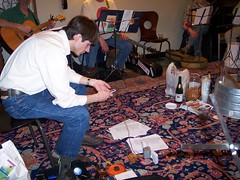
The problem is that they're discontinued and I couldn't find 'em for sale anywhere. So I've ordered up the Panasonic RPSPT70 Folding Travel Speakers and the Sentry Clamshell Folding Amplified Speakers to see how they work for me. My criteria are:
- Loud enough to play along with during jam sessions and practice
- Compact enough to carry in my banjo gig bag
- 4 hours or more of battery life
Things I learned at this week's banjo lesson:
- We discussed my recent performance of Good Old Mountain Dew as a member of the Hump Night Thumpers
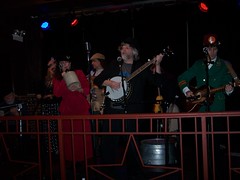
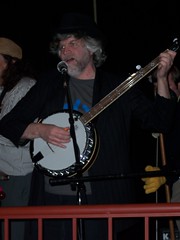
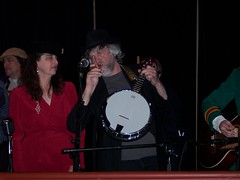
- Although Dave and I had discussed my doing a speed-up (or two) in the middle of my performance, and despite having practiced it this was with the Thumpers, I chickened out at the performance and just played it the same speed throughout. If just didn't feel right at the time. Dave thinks that was wise. "If you're not comfortable, don't do it."
- At one point my fifth string capo slipped and pressed the fifth string, changing its from a G to an A. I managed it pretty well, I thought, by simply avoiding the use of the fifth string until I could sort it out. Nobody seemed to notice.
- I was pleased with my microphone work. I'm glad that Dave and I had discussed this (same link). Some other helpful advice came from Arlo, who had advised me at a Thumpers class to pay attention to the sound of my vocice coming through the speakers and to adjust the distance between my mouth and the mic until I liked what I heard.
- This led Dave and me into a further discussion of microphones.
- Most mics are unidirectional, cardiod microphones. They are "cardiod" because their sensitivity range is heart-shaped:
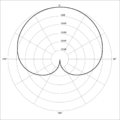
- Lavalier microphones are usually clipped to the body and are omnidirectional.

A recent trend is to wear a small headset that holds the lavalier mic a short distance from the mouth.
It occurs to me that this kind of headset would make an awesome kazoo holder. - The can mics used in old-time radio are bidirectional.

- A consequence of making the mic unidirectional is the proximity effect. As you get closer to the microphone the bass builds up. The cleanest sound is usually achieved by being about and inch or two away. You can take advantage of the proximity effect in your performance. Dave says to watch a good Sinatra performance to see how Frankie works the mic.
- An advantage of unidirectional mics is that the reduce the feedback from monitors. A monitor is a set of speakers that faces toward the musicians, away from the audience, that lets the musicians hear what they sound like. Personal, in-ear monitors are frequently paired with lavalier mics.
- When recording a choral concert, Dave will often place a hang single microphone from the ceiling, above and behind the conductor.
- Most mics are unidirectional, cardiod microphones. They are "cardiod" because their sensitivity range is heart-shaped:
- Dave went to a workshop with Bill Evans. I took a couple of sessions with Bill at last year's Midwest Banjo Camp and I look forward to seeing doing so again in a few weeks. Some of the Bill-Evans-related things we spoke about:
- Bill plays with the interval of muting; basically he does a vamp-style thing and take longer or shorter amounts of time to dampen the strings vibrations depending on the effect he's aiming for.
- At the workshop Dave attended, Bill showed them some 2-measure roll patterns. Dave and I work on these patterns a little.
- I really enjoyed Bill's all-levels session, "Playing Relaxed: It All Starts with the Right Hand." I recorded that session and should review it again.
- We discussed the array of sounds you can get from a banjo, including treating the banjo as a percussion instrument. This leads to a discussion of steel drums. I'm reminded that I've got a steel drum that my grandfather brought back from Barbados when I was around 10 years old. I should pull that out and mess with it.
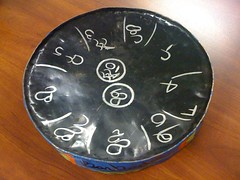
Dave says that steel drums were literally a revolutionay instrument — the powers that be had outlawed and confiscated musical instruments to prevent the spread of revolution through music and, in response, the people pounded drums out of the steel canisters. - I told Dave about someone I'd seen at my last Thumpers class who'd played what he called a canjo, which was just an open soup can, a wire and a stick. He put wire under his left underarm, pressing the stick against his back and creating tension between the stick and the can, which was in his left hand. Then he increased the tension by pushing the can away from his body, changing the pitch of the string, which he plucked with a guitar pick.
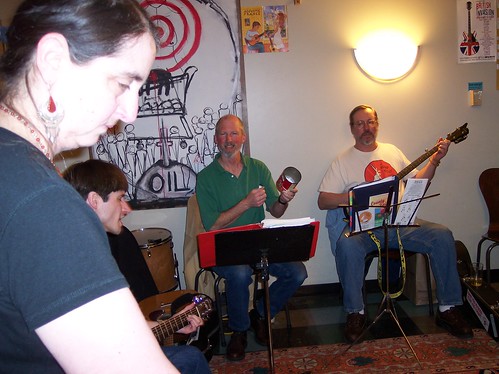
I figure if this guy can get an impressive sound out of one string I ought to be able to do even more with five. - Two iPhone apps that I've found handy: OmniTuner and Metronome.
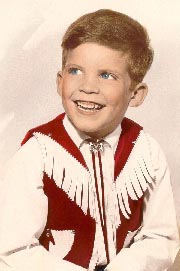

No comments:
Post a Comment